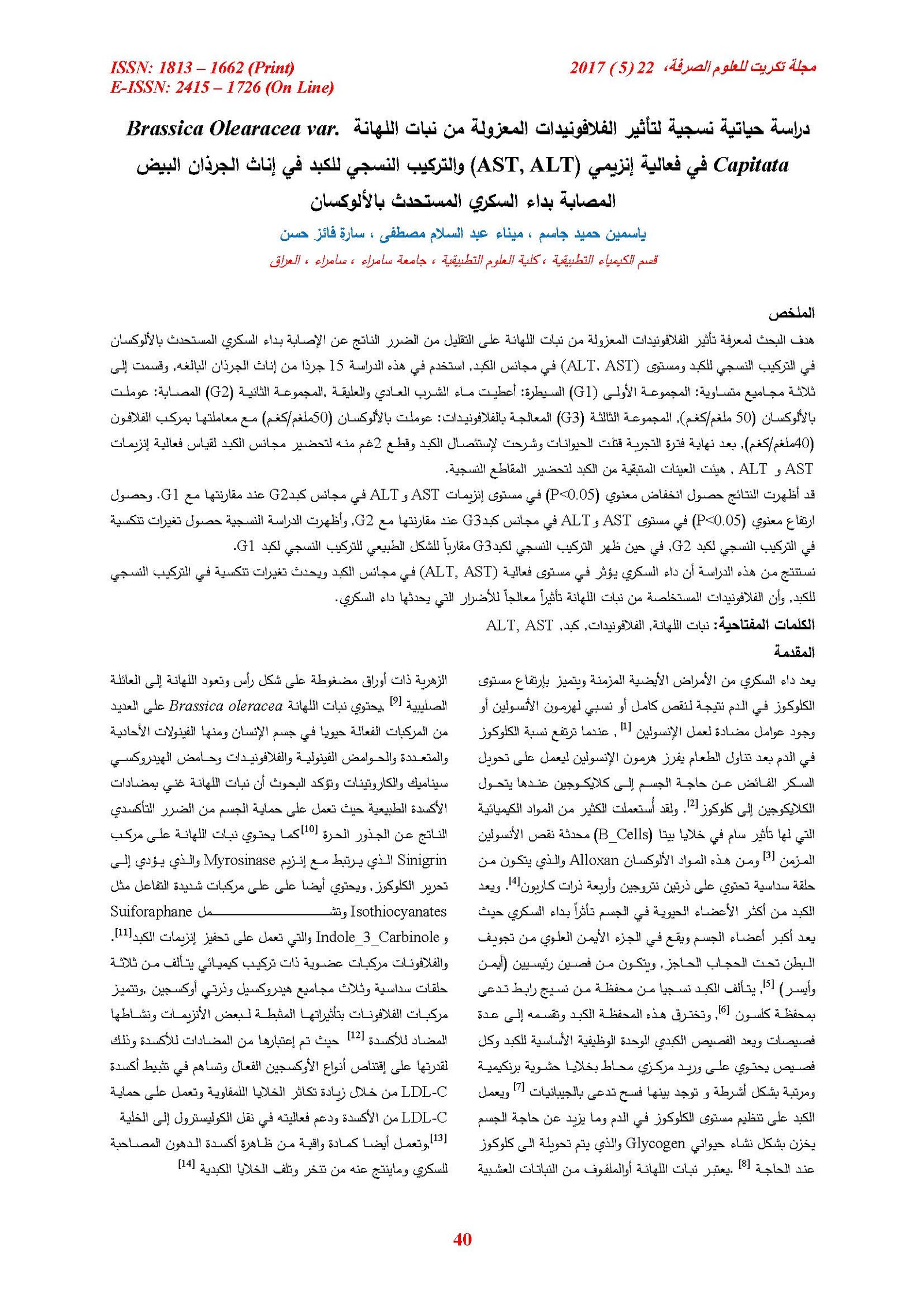Biohistological study of the effect of isolated flavonoids from Brassica Olearacea var. Capitata in the effectiveness of (AST,ALT) and liver tissue structure in alloxan induced diabetic white rats females.
Main Article Content
Abstract
The study was designed to recognize the effects of flavonoids isolated from a Brassica oleracea plant to minimize the damage caused by diabetes induced by alloxan in the histological structure of liver and the levels of the (AST,ALT) in liver congeneric.
Fifteen female albino rats were used and divided into three groups equal: First group: control animals were given water and food, Second group: animals treated by alloxan, Third group: treatmed by alloxan and flavonol in peritoneal injection.
At the end of experiment all animals were sacrified and dissected to obtain the liver and Two grams was cut to measure the effectiveness of liver enzymes (AST,ALT), the remaining samples were prepared for histological sections and examination.
The results clarified: A significant decrease (p≤o.o5) in the levels of (AST,ALT) in the liver of G2 when compared with the G, There are a significant increase in the levels of (ALT,AST) in liver of G3 when compared with G2, Histological examination showed occurrence of degenerative changes in histological structures of the rats liver of G2, and infiltration of composition in rats liver of G3 approached natural form for the installation of G1rats livers.
conclude from this study that diabetes effect the effectiveness of enzymes levels (AST, ALT) in the liver and the degenerative changes in the structure of liver, and that the flavonol extracted from Brassica Olearacea var. Capitata has a treated effect of the damage caused by diabetes.
Article Details

This work is licensed under a Creative Commons Attribution 4.0 International License.
Tikrit Journal of Pure Science is licensed under the Creative Commons Attribution 4.0 International License, which allows users to copy, create extracts, abstracts, and new works from the article, alter and revise the article, and make commercial use of the article (including reuse and/or resale of the article by commercial entities), provided the user gives appropriate credit (with a link to the formal publication through the relevant DOI), provides a link to the license, indicates if changes were made, and the licensor is not represented as endorsing the use made of the work. The authors hold the copyright for their published work on the Tikrit J. Pure Sci. website, while Tikrit J. Pure Sci. is responsible for appreciate citation of their work, which is released under CC-BY-4.0, enabling the unrestricted use, distribution, and reproduction of an article in any medium, provided that the original work is properly cited.
References
1.Sakahar, D,; Sekahar, B,; Ranabir, S. and Subhash, M. (2008) Antidiabetic effect of matured fruits of Diospyros peregrine in alloxan induced diabetic rats. Int. J. gre. Pharm. 2(2):95-99.
2.Choate, C.J. (1998) Diabetes mellitus. Part one. Modern medicine and traditional Chinese medicine. J. Chin. Med.3:237-245.
3.Okamoto, H. (1990) Molcularbiology of the islet of Langerhans. Chambrige university press.PP:209.
4.Ellis, GGP. and West, G.B. (1992) Progress in medicinal chemistry. Butterworth. Heinemann. PP: 65-67.
5. Thibodeau, G.A. and Patton, K.T. (2003). Anatomy and physiology. 5th ed . Mosby . London . pp: 829.
6. Faller, A. and Schunke, M. (2004). The Human Body An Introduction to Structure and Function.4th Edition. Translated by Oliver French, M.D.; edited by Ethan Taub, M.D. New York .
7.Mckiley, M.and Olouchlin, V.D. (2006) Human anatomy. Mcgrow Hill. Boston, New York. PP: 625, 816.
8.West,R.(2002) Anatomy and physiology for nurses 11th ed . Bailiere Tindall. London. PP:303.
10.Jahangir,M,Kim,H.K,Choi,Y.H and verporte, R. (2009). Health Affecting compounds in Brassicaceae. Compr. Rev. Food Sci. Food saf.,8,31-43.
11. Podsedek, A. (2007). Natural antioxidants and anti-oxidant capacity of Brassica vegetables. A review. Lwt - Food Sci. Technol., 40,1-11. Res. Technol., 222,88-98.
12. Dragan, T.V, Milena, T. N, Stephanie, V. I, Jelena, B. S,and Vlade, B. V. (2007). ''Extraction of Flavonoids from garden (Salvia offienalis I.,) and Glutinous (Salvia glutinosa I.,) Sage by ultrasonic and classical maceration'' Original Scienfific paper J. Serb. Chem.-Soc.; 27(1) 73-80.
13. Carrero, P.; Oretega, H.; Matinez, B. J.; Gomez , C .D.; Lasuncion ,M. (1998)" Flavonoid-induced ability of minimally modified low density lipoprotein to support lymphocyte proliferation". Biochem. Pharmacol. ;55:1125 .
14.Majumdar, A. Saraf, M. Andraves, N. and Kamble, R. (2008) Preliminary studies on the antioxidant activity of Tribulus terrestris. and Eclipta alba. Phcog.Mag.4 (13):102.
15.Harborne, J.B., (1973) Phytochemichal methods. Aguide to modern technique of plant analysis, 1st. Edn., Printed in Great Britain by Cox and Wyman Ltd., London, PP.52-73.
16. Murthy BK, Nammi S, Kota MK, Rao RVK, NK, Annapurna A.(2004) Evaluation of hypoglycemic and
antihyperglycemic effects of Datura metel (Linn.) seeds in normal and alloxan-induced diabetic rats. J. Ethnopharmacol.91,95-98.
17. Morton , K.; (1954) The purification of alkaline phosphates of animal tissues, J. Bio .chem., 57: 595- 603.
18.Prakasam, A. Sethupathy, S. and Pugalendi. (2004) Influence of casearia esculennta root extract on protein metabolism and marker enzyme in streptozotocin - induced diabetic rats. Pol. J. Pharmacol. 56:587-593.
19.Jagadeesan, G. and Kavitha, A.V.(2006) Recovery of Phosphatase and transaminase activity of mercury in toxicated Mus musculusl. Liver tissue by Tribulus terestris L. (Zygohyllaceae) extract. Tropical Biomed 23(1):45-51.
20. Macseen. R, and Whaley, K. (1992). Muirs text book of phathology. Bth ed. ELBS with Edward Arnohd.
21.Kecui. X, Keyixu. V, Murthy. (2004) Progress in neuropsychophar _ macology and biological psychiatry journal abbreviation, 28 (5).771.
22. Valko M, Rhodes CJ, Moncol J, Izakovic M, Mazur M (2006) Free radicals, metals and antioxidants in oxidative stress-induced cancer. Chem Biol Interact 160:1–40.
23. Arikan, S. Durusoy, C. Akalin, N. Haberal ,A. Seckin,D.(2009). Oral diseases; 15:512-515.
24. Giovannucci E, Maserejian NN, Rosner B, Joshipura K. (2006). Int J. Cancer; 120: 970-977.
